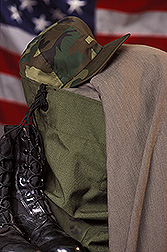Wool Biopolishing Process Scratches the Itch Factor
|
|
From the agency that brought you permanent-press cotton and permanent creases in wool trousers in the 1960s comes an exciting new breakthrough.
Researchers at the ARS Eastern Regional Research Center in Wyndmoor, Pennsylvania, have developed a biopolishing method that makes scratchy wool feel silky smooth. Not only does it remove the itch factor, it also bleaches the wool to a high level of whiteness and alters the surface of wool fibers to make them shrink-proof.
According to Jeanette Cardamone, a textile chemist in the center’s Fats, Oils, and Animal Co-products Research Unit, their method increases smoothness and shine on the fabric’s surface by removing fiber-yarn ends projecting from it. This contributes to a pleasing feel, which increases wool’s appeal for fashion uses.
The process involves two steps. First, an activated peroxide bleach is used to whiten the wool fibers and remove the protective lipid barrier that surrounds them. This step bleaches the wool at lower temperatures and in half the time as conventional techniques, which cuts processing costs, according to Cardamone. And because it removes the lipid layer, the peroxide treatment also makes the fibers more receptive to dye.
“High-temperature dyeing is traditionally used with wool because of the lipid barrier to dye uptake,” Cardamone says. “Although wool has resilient properties, those high temperatures weaken the fiber. Our process lets wool be dyed at lower temperatures, preserving its strength.”
|
|
The second step—enzyme treatment—is what makes machine-washable wool a reality. The surface of a woolen fiber is covered with microscopic scales, somewhat like scales on a fish or shingles on a roof. Wool shrinks during machine-washing because the heat and pressure lock the scales in place. The enzyme treatment “digests” the scales so they can’t become locked. This controls shrinkage without loss of strength or elastic recovery.
The same lipid layer that makes wool resistant to dye uptake would usually protect the scales against such an enzyme attack. But the bleaching step removes that protection.
“No damage is done to the underlying fiber structure, and the fabric’s mechanical properties are not changed, because the enzyme activity is limited to the outside layer, or cuticle,” Cardamone says. An additive is used in both the bleach pretreatment and the enzyme treatment to keep the enzymes out of the fiber’s inner structure.
The process can be applied to everything from loose fibers to yarn, fabric, or completed garments.
Good News for Wool Industry
Washable wool has been available for about 35 years, but the processing required for it is not done in the United States. Wool fiber and fabric are conventionally made shrinkage resistant by a process called “chlorination.” Like the new ARS method, chlorination alters the fiber’s cuticle. But chlorination is not allowed in the United States because it produces chemicals of environmental concern. So we import all our shrinkage-resistant wool.
In the United States, wool is mainly a byproduct from breeds of sheep raised for meat and ranges in quality from fine to coarse. The new method could help the U.S. wool industry compete against countries like Australia, which produces a fine, soft wool from Merino sheep.
The U.S. military is interested in using biopolished wool, especially for manufacture of underwear for our troops. Cardamone says underwear garments currently being used by the military contain synthetic fibers that can burn and melt into wounds during combat situations. Wool, on the other hand, produces a self-extinguishing flame and a dissipating ash when burned.
By law, in fact, uniforms must be produced domestically or in a country with which the United States has a free-trade agreement. The Berry Amendment to 2004’s Defense Federal Acquisition Regulation Supplement and the Buy American Act require the U.S. government—in particular, the Department of Defense—to procure (generally) only U.S.-manufactured textiles and apparel.
Mill trials are under way specifically to meet military needs. The woolen-mill industry is interested in licensing the process, but if it is used for the military, no licensing is required. Military field trials are also ongoing.
Concurrently, textile mills are applying the process to new and existing wool fabric lines to evaluate its commercial value as a replacement for imported, chlorinated wool textile products. All processing can be completed by wool mills within the United States, promoting use of domestic wool.
ARS filed a patent on the technique. The American Wool Council, a division of the American Sheep Industry Association, provided partial funding for the research.—By Jim Core, Agricultural Research Service Information Staff.
This research is part of Quality and Utilization of Agricultural Products, an ARS National Program (#306) described on the World Wide Web at www.nps.ars.usda.gov.
For further information on U.S. Patent Application No. 10/730,208, “Methods of Improving Shrink-Resistance of Natural Fibers, Synthetic Fibers, or Mixtures Thereof, or Fabric or Yarn Composed of Natural Fibers, Synthetic Fibers, or Mixtures Thereof,” contact Jeanette Cardamone, USDA-ARS Fats, Oils, and Animal Co-products Research Unit, Eastern Regional Research Center, 600 East Mermaid Ln., Wyndmoor, PA 19038; phone (215) 233-6680, fax (215) 233-6795.
"Wool Biopolishing Process Scratches the Itch Factor" was published in the May 2005 issue of Agricultural Research magazine.









